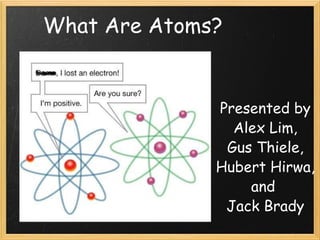
What are atoms?
- 1. Presented by Alex Lim, Gus Thiele, Hubert Hirwa, and Jack Brady What Are Atoms?
- 3. The Structure of Atoms An atom consists of: a small, dense nucleus, which contains:protons and neutrons, which are surrounded by electrons, which fill the remaining volume of the atom. The atom stays electrically neutral because the number of protons and electrons are usually equal.
- 5. : Protons : is a particle in the nucleus of an atoms. Protons are positivily charged (+1) unlike the neutrons. protons are stable particle unlike electrons.
- 7. Isotope Atoms with the same number of protons but different numbers of nuetrons. Since elements are identified by number of protons, isotopes allow for variations in atomic mass between atoms of the same element. Some isotopes of normally non-radioactive elements are radioactive.
- 8. Radioactivity Atoms get heavy. Stuff falls off. You might say it radiates. In an active fashion. Scientists are creative.
- 9. Electron Shells Electron shells are predefined orbits in which electrons move around the nucleus of an atom. Electron shells further from the nucleus correspond to higher energy levels. For an atom to move between electron shells, they must intake energy from some external source. Electron shells also allow for bonds to form between atoms.
- 10. Functions of an Atom The Atoms function is to form the structual units of elements. There are 92 naturally occuring elements that atoms form. Each element is characterized by the number of protons in the nucleus, known as the atamic number. The picture below is a Helium atom, definable by its twin protons.